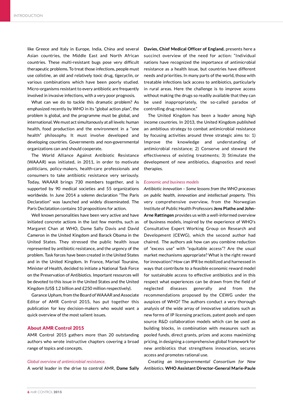
like Greece and Italy in Europe, India, China and several
Asian countries, the Middle East and North African
countries. These multi-resistant bugs pose very difficult
therapeutic problems. To treat those infections, people must
use colistine, an old and relatively toxic drug, tigecyclin, or
various combinations which have been poorly studied.
Micro-organisms resistant to every antibiotic are frequently
involved in invasive infections, with a very poor prognosis.
What can we do to tackle this dramatic problem? As
emphasized recently by WHO in its "global action plan", the
problem is global, and the programme must be global, and
international. We must act simultanously at all levels: human
health, food production and the environment in a "one
health" philosophy. It must involve developed and
developing countries. Governments and non-governmental
organizations can and should cooperate.
The World Alliance Against Antibiotic Resistance
(WAAAR) was initiated, in 2011, in order to motivate
politicians, policy-makers, health-care professionals and
consumers to take antibiotic resistance very seriously.
Today, WAAAR brings 730 members together, and is
supported by 90 medical societies and 55 organizations
worldwide. In June 2014 a solemn declaration "The Paris
Declaration" was launched and widely disseminated. The
Paris Declatation contains 10 propositions for action.
Well known personalities have been very active and have
initiated concrete actions in the last few months, such as
Margaret Chan at WHO, Dame Sally Davis and David
Cameron in the United Kingdom and Barack Obama in the
United States. They stressed the public health issue
represented by antibiotic resistance, and the urgency of the
problem. Task forces have been created in the United States
and in the United Kingdom. In France, Marisol Touraine,
Minister of Health, decided to initiate a National Task Force
on the Preservation of Antibiotics. Important resources will
be devoted to this issue in the United States and the United
Kingdom (US$ 1.2 billion and £250 million respectively).
Garance Upham, from the Board of WAAAR and Associate
Editor of AMR Control 2015, has put together this
publication for key decision-makers who would want a
quick overview of the most salient issues.
About AMR Control 2015
AMR Control 2015 gathers more than 20 outstanding
authors who wrote instructive chapters covering a broad
range of topics and concepts.
Global overview of antimicrobial resistance.
A world leader in the drive to control AMR, Dame Sally
Davies, Chief Medical Officer of England, presents here a
succinct overview of the need for action: "Individual
nations have recognized the importance of antimicrobial
resistance as a health issue, but countries have different
needs and priorities. In many parts of the world, those with
treatable infections lack access to antibiotics, particularly
in rural areas. Here the challenge is to improve access
without making the drugs so readily available that they can
be used inappropriately, the so-called paradox of
controlling drug resistance."
The United Kingdom has been a leader among high
income countries. In 2013, the United Kingdom published
an ambitious strategy to combat antimicrobial resistance
by focusing activities around three strategic aims to: 1)
Improve the knowledge and understanding of
antimicrobial resistance; 2) Conserve and steward the
effectiveness of existing treatments; 3) Stimulate the
development of new antibiotics, diagnostics and novel
therapies.
Economic and business models
Antibiotic innovation - Some lessons from the WHO processes
on public health, innovation and intellectual property. This
very comprehensive overview, from the Norwegian
Institute of Public Health Professors Jens Plathe and JohnArne
Røttingen provides us with a well-informed overview
of business models, inspired by the experience of WHO's
Consultative Expert Working Group on Research and
Development (CEWG), which the second author had
chaired. The authors ask how can you combine reduction
of "excess use" with "equitable access"? Are the usual
market mechanisms appropriate? What is the right reward
for innovation? How can IPR be mobilized and harnessed in
ways that contribute to a feasible economic reward model
for sustainable access to effective antibiotics and in this
respect what experiences can be drawn from the field of
neglected diseases generally and from the
recommendations proposed by the CEWG under the
auspices of WHO? The authors conduct a very thorough
analysis of the wide array of innovative solutions such as
new forms of IP licensing practices, patent pools and open
source R&D collaboration models which can be used as
building blocks, in combination with measures such as
pooled funds, direct grants, prizes and access maximizing
pricing, in designing a comprehensive global framework for
new antibiotics that strengthens innovation, secures
access and promotes rational use.
Creating an Intergovernmental Consortium for New
Antibiotics. WHO Assistant Director-General Marie-Paule
INTRODUCTION
6 AMR CONTROL 2015